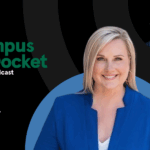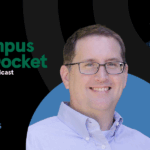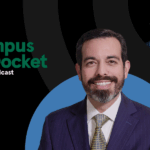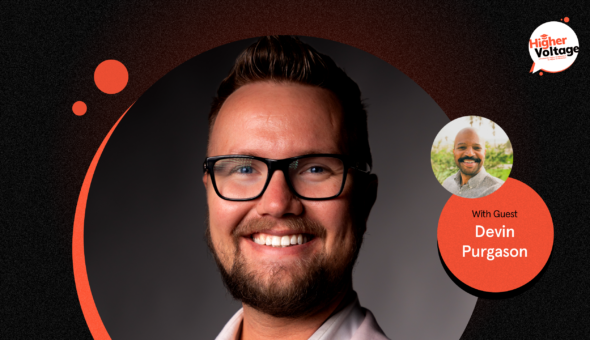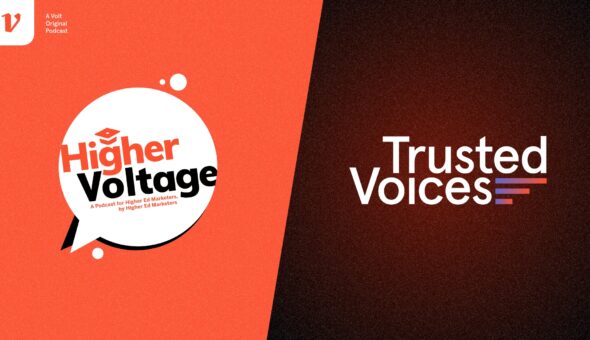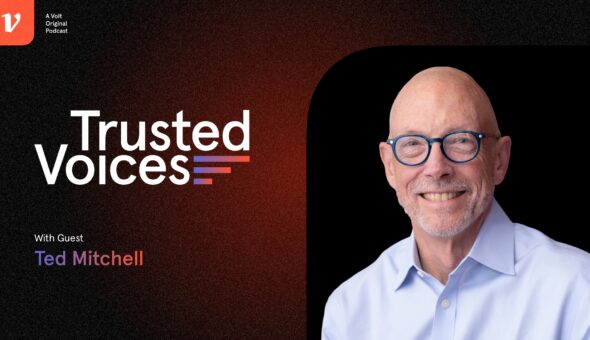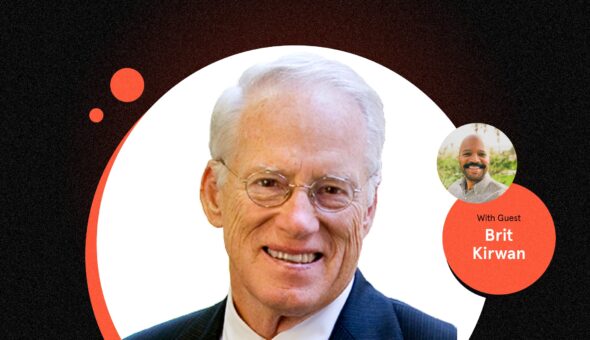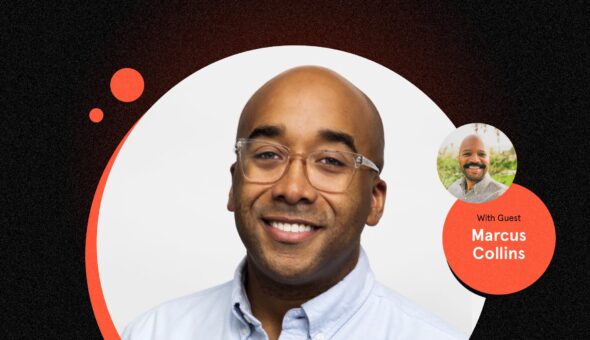Read the full transcript here
Kevin Tyler
Welcome back to Higher Voltage. I’m thrilled about today’s guest. Joining me today in the studio is Kelly Holland, Vice President of Strategic Communications and Engagement at the American Institute for Foreign Study. She has worked in higher education since 2007 and in international higher education since 2010. Kelly previously held roles at Towson University, Eastern Illinois University and Lehigh University before taking a role at Global Experiences, an international internship organization in 2016. Kelly has taught abroad with the Spanish Ministry of Education in Andalusia, Spain, and has led multiple study abroad programs with university students, and is a frequent presenter about mental health and well-being in the international education profession. Kelly, welcome to Higher Voltage. I’m so happy to talk to you about this topic I have wanted to chat about for quite some time.
Please share anything I did not cover in your introduction with our listeners now.
Kelly Holland
Thank you, Kevin. I’m so excited to join you and to talk about this topic that is near and dear to my heart as well. So, excited to chat with you. I don’t think I would add anything else. If there’s any CliftonStrengths nerds out there, this speaks very strongly to my communication strength to be out here talking about this today.
Kevin Tyler
Well, will tell you, I will come out right now and say that I am your CliftonStrengths nerd. I took that assessment for the first time about 10 years ago, and it has completely changed the way that I do everything about my work. So we can talk about that on, maybe another episode.
Kelly Holland
That’s a different episode, yes.
Kevin Tyler
Okay, so I guess the first question and you were so gracious in your explanation of this for me.
I’ve always called study abroad “study abroad,” but you were thoughtful to share with me that international education is really more of the phrase that we should be using. Can you talk about the differences between the two and why international education is the preferred phrase for what we’re talking about today?
Kelly Holland
Definitely, I think it’s a good way to distinguish the different types of opportunities that are out there, whether you’re talking to a student audience or talking with families, even working with universities and talking to advisors who are working directly with students or faculty who are teaching students.
There are so many things that you can do abroad. I am a study abroad student, and I would still say that because when I was in college as an undergrad, I went abroad during my junior year in the spring semester because of language, stayed with a host family. I ticked all the very stereotypical boxes.
So it was not until I went to Eastern Illinois University when I first really found out about short-term programming. What we call custom faculty-led programming, where you are led by a faculty member or a staff member from your home institution, typically for only two to four to six weeks, which is stunning when you think about semester-long programming.
So it’s really important to be inclusive in that way. And we name things like study abroad, which could be studying at a host institution overseas. It could be that faculty-led option I mentioned. It could also be intern abroad, in which case you could be interning with a combination, a study plus intern program. You could intern full-time with some organizations. You could be doing service learning, volunteer work. There are so many different ways now where students and adults can go abroad and experience international education.
Kevin Tyler
I think that’s a really nice table setting for the conversation we’re about to have. And it’s one that I’ve been looking forward to, as I mentioned at the top of the show, that I’ve been looking forward to talking about a lot. And that is how we market international education opportunities in a world that looks the way that it does now, right? It is much different than when I was in college, you know, decades and decades and decades ago, that the Semester at Seas and the conversation around it was somewhat different.
And we are now coming into a world where authoritarianism is on the rise. We have other kinds of global, kind of scenarios that are happening. And I’m curious what the conversation looks like when we start talking about marketing higher education from an international experiences perspective. And so because there’s so much going on in the world right now that impacts students and how they consider higher education, whether it’s political turmoil, campus protests, how students even consider the very value of a college degree.
Has that changed how you talk about international education or study abroad and how it’s marketed to 18- to 21-year-olds?
Kelly Holland
It’s a great question. I think that probably the core point I would like to say is that it still matters as much as it did previously in my generation and our parents’ generation and before, when the European tour was a thing that folks were doing in the US. And there’s a reason for that. It’s really important, arguably now more than ever, that we have a responsibility to make sure that students not only know and that their families are aware of the opportunity, but how to get it. Because I think it can often come across as something that is only for the elite. It is only for extraordinary GPAs and intelligent students from specific colleges and universities, and that is not the case.
So we have a responsibility to be more inclusive in our language and we need to be thinking about all kinds of students. And from a marketing seat, it’s also really interesting and important to me to think about how people learn. Because if I’m cranking out a website that has a ton of text on it, no one cares, right? No one’s going to read it. They might Control F and search for keywords, and I might be doing it for SEO purposes. But in reality, we need to be storytelling.
And I think that’s one thing that has changed in recent years. It’s this concept of being able to picture yourself in a place. Even five, 10 years ago, certainly before the pandemic, we would be thinking, OK, let’s look at these photos that we’re using, these static images, right? You’ve got the one that’s out on the Cliffs of Moher in Ireland, and someone’s jumping. There’s always a jumper. Someone’s got their arms out wide.
Sometimes you might not see their faces. You might see the backs of people. Or if the faces we see are all the same color or all the same shape and size, then we’ve got a different kind of issue. So I think over time, we’ve been thinking about not only who is telling the story, is this students who are predominantly white speaking to students who are predominantly white. We know that 70% of the students that currently go abroad are white and female.
How do we get those other stories in there? And how do we get that out to a wider audience of not just students, but also their families, their staff, folks who support them all through their college experience?
Kevin Tyler
I really appreciate the lens that you’re taking around diversity and inclusion in these opportunities and experiences. And I’m curious if you can just speak from a high level of like what the demographics look like. You already shared one, but what about some of the other demographic inputs that you can share about who is participating in these experiences and opportunities? Because I do agree with you that I think that there is a way that you could argue that international experiences are reserved for a certain type of population.
Kelly Holland
Sure, and I feel like it’s a stereotype that we are constantly thinking about. It’s not one that I want us to forget about because it’s historical and it’s important that we keep it in mind when we’re doing our work currently. And I’ll point to the IIE Open Doors Report. So that recently came out this week. It is International Education Week. And that report has now been on, I believe this is their 75th anniversary.
So this is a data set that tells us not only who is going abroad, so I would refer to that as outbound to US students who are headed outside of the US, but also inbound. So those international students who are coming to the US to be hosted here. And this is important for a whole lot of reasons, right? We’re looking at things like how much does bringing in international students affect the economy, right? What is that bringing in? And when we’re thinking about what kind of programs do we offer on our campuses, both here and abroad.
So IIE Open Doors this year for study abroad, it tells us there’s a lag, right? So we’re looking at academic credit-bearing opportunities. So that means a student has to go, return, and receive credit on their transcript. That’s why there’s a lag in the data. So when we look at this year’s data here in 2024, we’re looking at 2022-23 data.
And what that tells us for the demographics is, as I said, the majority of students going abroad identify as women. It’s currently at 67% in this data set. 34% of students identify as students of color. So this particular part has grown over the past 20 years, but it is still off the overall US higher ed trend. So oftentimes you might see at colleges and universities as they go through their strategic plans, they’re thinking about how do I get study abroad numbers and demographics to mimic what is at my institution? So working with institutions who identify as MSIs or minority-serving institutions, HBCUs, others who are trying to make sure that their numbers match what they’re bringing into the institution.
Kevin Tyler
That’s incredible. Can you share how some of those trends have fluctuated kind of before and after COVID? I think that there’s like, obviously, you know, international experiences may have dwindled a little bit during the 2020-22 time period, but how is that starting to recover, if it is, after the pandemic?
Kelly Holland
It is, the numbers are on their way back up. We are not there yet. Just as with everything else, COVID put a pause on international education, which was true for outbound and inbound. We were unable to send or receive students. And, for the purposes of the data, it’s also interesting to know it didn’t happen the same across the United States.
Different colleges and universities have different thresholds for risk. So not everyone was willing to send in 2021 or even into 2022. So, term by term, schools and institutions were making these decisions about when it would be safe and when it would be reasonable to start sending students again.
I think, many people that you talk to in the field of international ed remember 2019 with this golden glow, which may or may not be reality. But before times, right, there’s this there’s this feeling of, we were right there. It was, we were at the peak, we were at the pinnacle. And that can be hard sometimes when you’re thinking about, well how do we get the numbers back up and how do we drive the interest again?
The students that we have today post-pandemic are not the same students that we had before. These students, these individuals, these families are so different. So, we have to pay attention. We have to ask good questions. We have to get in there and figure out what it is that they want to be doing, not only for study abroad but also in college. We’ve talked about the demographic cliff. That’s not something that international ed is isolated from.
We are looking at the next several years, decades of students who should be coming our way. And it’s important to pay attention to what they’re signaling, whether it’s through what they’re studying. We know that foreign language, for example, has gone down in terms of interest. As a second language speaker, that breaks my heart a little bit, but we’ll look for the return. We’ll hope that will come back. So the data helps us, but there’s also a story beside it. So we need to be talking to people and getting feedback from students, from advisors to know what’s really going on with their numbers because data is one thing, but that qualitative anecdotal side is another that will tell a more full picture.
EK ad read
Kevin Tyler
I’m so curious to pull the thread on the differences in the students from before the pandemic and after. I think that argument could be made of students who are not looking for international education opportunities as well. We’re just dealing with different types of people after living through a global pandemic. And I’m curious if you can kind of share some of the details about the differences that you’re experiencing and some of the students and families that you’re dealing with now that might be that were different than from before.
Kelly Holland
Sure, I think part of it is also think about how education exists, not in a bubble, but in relation to everything else going on, right? You’ve talked about politics, but let’s think about the job market. Let’s think about international education as a means to get to career readiness for a student. We know that NACE uses career competencies, for example. So, NACE being National Association for Colleges and Employers, and they are thinking about, well, what are students’ intercultural capabilities? And our question is, how are students going to get that if they don’t leave their campus or their city or explore their community or get out abroad?
One area that I did not mention earlier, which is worth pointing out, is study away. And this phrase has to do with domestic study abroad. So that means it could be national student exchange, which is a very formal setting. It could also be that faculty and institutions are taking students away within the US. They might live and work in Maryland, and they’re going to Arizona on spring break and things like that.
So, I think that is a reflection of risk and how we interpret risk and risk tolerance of students and families because going to Arizona sounds a little bit more palatable than going to Spain or going to, you know, somewhere further away. But there are still students who are going to Asia. They are going to school here in the US, and they’re going all the way to South Korea, to Japan. And there are very different reasons for that. Their exposure to international students or international communities, to different things in social media, to pop culture. There’s a lot of reasons that students can be drawn outside to different areas.
The students that we see today are critical thinkers in a way that maybe we wouldn’t have seen in the past. We don’t encounter students who expect to study abroad. They need to plan for it. Being a student now in college is so challenging. They have to have a four-year degree plan almost from the start, and we have to find a way for study abroad and international education to fit. So how is the engineer going to go? How is the computer science student or the educator going to go abroad?
And when we think about all the different planning and all those mechanisms, it’s about working not with the student, but with the institution, because the institution has to have a culture of study abroad. So that when the student and the families arrive, they feel that and they see that and they see not only is it in the strategic plan or it’s in what the donors are paying attention to, it shows up in the makeup of the campus, it shows up in the makeup of the class that they join. And so I think between risk and in general anxiety. Anxiety is another one that I’ll point to. We know that coming out of the pandemic, I think all of us are probably a little bit more anxious. And a good place to point to this in relation to international ed is academic credit.
So there are processes in place so that when students take courses abroad, they need to be articulated back into their US institution to be on their US transcript. And there can be uncertainty tied to that. We’re working with different host institutions, host countries, different educational systems in terms of how credits are given and granted and the timing. And that may sound like a small piece of anxiety, but when you’re trying to graduate on time, it can really matter.
Kevin Tyler
Yeah.
Kelly Holland
Risk, anxiety, those both sound like negative things, but I would also add resilience. I want to give you a positive thing here. One of the things that I’ve been thinking about in addition to how folks learn is also asset-based language. We talk about that in our organization, and we have an excellent director of inclusion initiatives who, I think, has given me a lot to think about over the past few years that she’s been working with us. And one of those things is trying to find the positive in what we’re talking about.
We work a lot with first-generation students as an example. And when I think about resilience, I think about them. And I am one, so I’ll be resilient too. But I think sometimes when we talk about first-generation students as an example, if we were to lean deficit model language, we’d be saying they need a lot of hand-holding. But in reality, the first-generation student is very well equipped to handle a lot of information. They are coming to college on their own, trying it on their own. Maybe they need more time, but if you give them the information upfront, they can rise to the occasion. And so I think in the mix of this risk and anxiety, I also see resilience. I see students who are focused and ready to go.
Kevin Tyler
I love every second of what you’ve just said. I love that it feels like an opportunity that is for everyone. I have never thought of international education in this frame before. So I’m really grateful for the time you’re spending talking through this with me today. I was raised by parents who really valued exposure to things. Like they were always sending us to things so we would have a sense of how the world kind of worked. And as an adult now who is somewhat regretful for not taking advantage of the study abroad opportunities and international opportunities that existed at my institution, the University of Pittsburgh, back in the day, I have grown into an avid traveler with my partner. We go on trips every year. We come back with these lessons learned around the exposure. We learn about other cultures through all the things that you learn about culture.
I’m curious about how you talk about the benefits of an international education experience in the context of today’s political climate because it feels like in some places it can become like a sensitive conversation when you talk about exposure to other types of people, cultures, food, diversity, all these kinds of words that have become almost lightning rods in our country. How do you go about relaying all of the really incredible benefits of exposure of this type in international education?
Kelly Holland
You make a great point about this concept of exposure, right? How do we know unless we get out there and see it or feel it ourselves? I think that’s why storytelling really steps up in this situation and where we find ourselves today. We are in the thick of it with DEI legislation, and there are many institutions, AIFS Abroad works with several hundred across the US, and there are some who have indicated to us a whole variety of different concerns that they cannot use the word “diversity” any longer, that they cannot have staff that hold those titles, that they cannot market these programs, that they just are running into so many different things.
Recently, just this week, someone shared with me that scholarships had to be reviewed at a higher level because they were using these keywords. And it makes my head explode a little bit. But this is where we hope that organizations that are private or nonprofit and not held to some things that state institutions may be is that we are stepping in to fill that need. And what that means is if they can’t run a Black in Paris program, we can. And we can open it up, and we can generate that interest and bring those students, those faculty, whomever is there. That’s the big one to step into, right?
And it’s training, it’s conversations that, again, our director of inclusion initiatives may hold here internally with our company, and many of us are remote, so they’re often online, she’s connected with our onsite staff, but it’s going onto campuses and doing that for them. But always being mindful of the language that’s currently appropriate on that campus. So sometimes, we might hear belonging instead or, you know, people are starting to use different types of language.
Our messaging will not change. It will remain the same, that is available for everyone. But we are in a very privileged situation that we’re able to do that. So some of the interesting things that we’ve been doing that I find impactful have been listening circles. So, kind of, a pretty neutral situation to just pop up and hold space for these conversations so that people can come and not only let us know what they’re experiencing on their campuses, but let each other know.
Because if we’re sticking with the topic of resilience, I will tell you that practitioners in international education are particularly resilient. Many of us worked through the pandemic, and prior to that, we were working through 9/11 or bird flu or who knows what else, right? You know, different world incidents where we’ve had terrorist attacks and things like that. And international ed has persisted this entire time. And so, there’s a lot of thinking about, okay, I heard what you said that we’re not supposed to do that. And I see where it came from. But I still believe that international education matters. So how do I get there? And so there’s a lot of resourceful people in the international ed who are working to make sure that those messages are still getting out.
Kevin Tyler
That’s wild. What’s the relationship between like when it comes to nuts and bolts like marketing, like getting it done? What’s the relationship look like between you and the institution? Like how do you, what’s it look like?
Kelly Holland
Yeah, great question. Really depends on the institution.
Kevin Tyler
Of course.
Kelly Holland
So let’s say, for example, we’ve got a big flagship university that has a lot of folks in the office and they’ve probably got a rockin’ student staff and they’ve got graduate assistants and different folks who can chip in in terms of social media, marketing, blogs, writing, content, different things like that.
Other institutions might be smaller, just in office size, so not a lot of resources. And we would call those folks one-person offices. Those are pretty common in study abroad in particular. And they may need us a little bit more. So that could be that we are working together on something like a flyer, right? So we’re creating something in print. Again, coming back to how do different people learn? So what is it that’s going to be impactful on their campus?
Social media for us will continue to be, I think, a big avenue. And one of the things that is the most useful in terms of storytelling is an Instagram takeover. It’s getting students who are currently on site from these different institutions, they go online for a period of 24 hours, and then that story can be saved and shared back to their institution. And then of course the student has that 15 minutes of fame as a celebrity in their location, and they can share that back. And then also the school can use it to say, this is what a marketing student at our institution did in Madrid. And this is what you could do as a marketing student.
Some of the marketing pieces I think that are becoming more prevalent have to do with that academic credit and thinking about the majors that the students are involved in. Are you a business student? Are you a STEM student? What is it that you’re studying, and why would you go abroad? So, there’s a little bit of thinking about the benefits of studying abroad. Why would you do it? Why would you intern instead of study abroad? Coming back to career readiness and things like that that we can point to. So sometimes it’s offering content that they can reuse on their own or going as far as social media, videos, things like that.
So, it’s a collaborative process, which I think all of us really benefit from. We as an organization learn a lot about the processes and the hurdles, the challenges, the benefits at universities. And that’s helpful too, because then we can also, I guess, matchmake in a way. Because when we meet with someone who says, really want to get more of my computer science students abroad. And we can say, well, I know Kevin at this institution and you should talk to him because he’s figured out a way to do this. And then we’re connecting people.
So, it’s not just marketing. It’s yes, we can help you market your program, but also we can put you in touch with someone else. So, the international education field has a really robust network of individuals, and it’s also changing. There’s a lot of new people who are joining and as folks retire and new folks join, it’s heartening to see that people continue to join international education positions, especially coming out of COVID.
Kevin Tyler
Just kind of a personal curiosity. Are there any trends or insights that can be culled from where people are going, where people are selecting to study? I’m always curious like what drives people to where they’re going, but also like what you are learning and being so entrenched in this work about the sites people are selecting.
Kelly Holland
Yes, I think that it’s one of those situations where everybody is paying attention to this. So, you’ve, it’s your personal curiosity, but it’s our business. So, we are thinking about it, too. A lot of what we see and have seen years on years on years from the Open Doors report is that Western Europe is dominant as a location. And that could be a whole different episode you and I can talk about.
Kevin Tyler
Yes, I’m sorry.
Kelly Holland
Why are they all going to Italy? What is it that draws students to Italy when we know that Italian foreign language programs are not prevalent across the US? And what is it that brings them there? What is it that brings them to the UK, predominantly to London, to Spain. So Spain is where I studied abroad. So of course, I always am thrilled to hear when students want to go to Spain. But they have been in the top three for a long time, Italy, the UK, and Spain. And we’re talking like thousands of students, right?
So I’ll give you an example from this year’s Open Doors: 41,840 to Italy, 35,018 to the UK. So even that gap is wild, right? There’s a lot of students going to Italy. So, I should also mention that we’ve got France, Ireland, Japan, Germany and Costa Rica rounding out the top eight. So, they are not all in Western Europe.
But one of the things we find in working with colleges is typically the administration may say, well, we believe that students should or could or definitely need to go to, let’s say Asia, right, for a thousand reasons. But the student population for whatever reason is not interested. They’re not, it’s not somewhere they want to go or they’re not familiar with it. So, we’ve got to do some background education. So, a lot of times I think it’s reconciling where does the strategic plan tell you to go, but where do your students actually want to go? Some of your previous guests have basically said, ask what students want, right?
Kevin Tyler
Exactly. Novel concept.
Kelly Holland
Like, are we paying attention? So, I think that also adds lead time though. Let’s say for example, if someone is interested in, let’s get them abroad in this location in 2025. We need lead time. It can be really hard to get students on an official program in a short period of time. So 12 to 18 months can be a good lead time for getting students abroad. So if folks are targeting different locations, it takes time to plan. It takes time often at an institution to work with your procurement department, go through a bidding process, do lots and lots of paperwork. There can be, very exciting. There can be just some administrative pieces that can slow down that creative process.
So, there’s a lot of conversation about getting students outside of Western Europe, whether that’s Global South, whether that’s specifically to Asia, to Africa, but that’s kind of the current situation. And remembering that this data is 22-23, so we may see some changes, but I can tell you those top three have been pretty tight for a long time.
Kevin Tyler
That’s interesting. Do you think, is that just like industry based? Like if I’m trying to be an international business major, is that where the places where that is ripe, or is it just kind of randomly selected? Just out of curiosity.
Kelly Holland
Well, we’ve got fields of study as well. So this is also something to think about, is who’s going abroad when you think about what are they studying. Open Doors tells us in 22-23 that in the majority of students when we’re looking at their majors, the fields of study, is that 20% are from business and management. So yes, you’re international business majors and social sciences. So that’s another 18%. So that’s kind of where the most popular majors are.
Is that why they’re going to Italy, the UK and Spain? I don’t think they’re related. I think that we might find if we dig into the data, which I have not yet had the chance to do, business majors are going a lot of different places. It could be a few things. What’s available to them, which means what has their college or university offered to them, or what have they found on their own. It could also be word of mouth.
It’s really important to remember that that storytelling piece is when students have gone to Florence and had an amazing time and come home and tell everyone about Florence. Then the effort there, after the fact, is someone comes into a study abroad advisor’s office and says, well, Kevin told me that Florence was amazing. I’d like to go to Florence. And so those locations, I think in particular, really lend themselves to that. They’re also pretty prevalent on social media.
Kevin Tyler
Yeah.
Kelly Holland
You know, Italy gets named for many, many, many things. London comes up often as a huge metropolitan city. Spain’s a little bit different. Spain has so many different cities and so many different vibes and feelings and food and, it is one of my heart places, right? It’s a place that I call very dear. So it’s very different, I think, what draws students to different locations.
TVP ad read
Kevin Tyler
I am so curious the types of questions that you might get from families who are exploring these types of experiences and opportunities for their students, and if they’ve changed over the last couple of years, they’ve gotten, how it’s changed and evolved, those questions.
Kelly Holland
Yes, the questions are largely the same. So even in that pre-pandemic time, they were always asking about safety.
Kevin Tyler
Of course.
Kelly Holland
Always asking about academic credit, insurance, and finances. Those are, I would say, the top four. We were just having a discussion about this this week because we are super focused on families as stakeholders in terms of international education. So this is a space where not only the student studies abroad. Students are part of a unit. They’ve got a support network. They could be making decisions not only to what to enroll in on campus but also what to do off campus. Where should I work? Where should I intern? Should I go abroad? If so, where?
IIE is partnered often with our foundation arm, so the AIFS Foundation. So they recently co-published a second edition of a Family Guide to Study Abroad, and it is now up to 90 pages and it is a really robust guide. It came out last 10 years ago. So as a contributor on this particular piece, going back and looking at it, even just some of the language we were using, it seems so outdated just a decade later.
So having this new resource is something that let us think about your question a lot, which is, what do families need to know? What should all families know? Right? We have this responsibility to raise awareness about the entire experience. So not just that it’s beautiful and you could take that jump photo in that certain location, but also there are safety considerations and definitely financial considerations. So a lot of times when we’re talking about families, we’re talking along the lines of those probably four core things.
Kevin Tyler
I think that it’s such an interesting idea to be someone in college living in another country, getting credit for the things that you need to get credit for, and coming back with these rich stories. You shared the social media piece around the takeovers on Instagram. You’ve shared the importance of storytelling. How else do you leverage the alums who are coming back?
For lack of a better phrase, in your marketing efforts that really feels like new, innovative, that other kind of on-campus marketers might be able to borrow or learn from.
Kelly Holland
Absolutely. I think that in the same way that alumni are incredibly meaningful components of a marketing strategy at an institution, the same is true when they come back from an international ed experience. We and many other organizations have alumni ambassador programs, and they really can range in structure. What we’re doing is inviting students to kind of continue their experience a bit, right? Because reentry is a real thing.
Kevin Tyler
Yeah.
Kelly Holland
For individuals to come home after really impactful experience, they’re going to go through reverse culture shock. And maybe now more so than ever, it will be wildly important to support students who are coming home this spring, this summer, coming in with a new administration and just lots of different changes here in the US as well. And so, there is a section in the guide specific to reentry because it’s important that we look at the experience before, during, and after. So we want to make sure we’re thinking about it holistically.
So, what I would suggest for marketing purposes is when you work with alumni, you’re inviting them to tell their story, but they also need to remember the whole experience. Not just that one really cool thing that they did, but asking really critical questions, right? The five why’s. Get them to continually explain why to you. Why did they go in the first place? Why did they choose Spain or Italy? What did your mom say? What were the courses that you took and things like that?
I think, starting to do that with Instagram takeovers and spaces where we can see the students’ perspective, it’s become even more valuable to get the family’s perspective, whether that’s in an interview or a podcast or just different ways where you can say, we recognize that you’re making these decisions as a group. It’s not so often that students would make this decision alone or independently. They’re likely bouncing ideas off of someone.
So it’s also important to think about the language we’re using. You and I had a chance to talk about this briefly, the difference between parent, family, support network or support system. And so it’s acknowledging that students now, even first-generation students in particular, may be supported by a whole range of different people. So making those things available to a variety of people, letting the student select who needs that additional information.
Kevin Tyler
I very much appreciate that it feels like you deal in cultural exposure and experiences, and the way that you do business reflects that sensitivity, right? And thinking about how we are being inclusive in our terminology, how we are being inclusive in who we are marketing to. And I think that that is a critical part around being like, and I hate to use this word right here, but authentic in how we are telling our own story. We can say what we want to say until we’re blue in the face, but if the practices and policies that we have in place don’t reflect what we’re saying in the world, I think that is what’s called dissonance. And so, I very much appreciate that AIFS not only says the right thing but also feels like it operates in the right ways that uplift or elevate what we are saying in the world, in terms of diversity, equity, inclusion, and belonging. I think that’s an important part that I’m learning about in this conversation.
Kelly Holland
Thank you for saying that. I think what our colleagues would probably say is it’s a practice and it takes a lot of work. It also takes a lot of intentionality and really just being open to conversations about we really could have said this better or if we chose to do this differently, what would we do? So I think there’s a lot of times we have the ability for continuous feedback, which is super important with international ed. It’s to your point, the stereotype about study abroad only being available to a certain group of people is something that has to be talked about all the time by all sorts of people so that we can bring it into a wider group and open access to it. So thank you for that.
Kevin Tyler
No problem. Thank you for that. My last question is one I ask every person who comes on the show, and that is what you think higher ed is going to look like in about five to 10 years from your perspective.
Kelly Holland
I will tell you, true confession, I took this question to several friends and colleagues and had a grand old time talking about what we thought might happen. So thank you for that invitation.
I think that even just thinking, okay, the family guide came out 10 years ago. I look at it now. I look at how we talked about the experience and I can see how the language has changed. I think that our opportunities will continue to change. A good example would be COVID showed up, and we couldn’t send students abroad anymore, and it had been happening prior to the pandemic. Different organizations were bringing the concept of online learning, right? Online global learning, COIL, all these amazing programs that were made possible in a virtual environment and arguably are more affordable and accessible and open to a wider variety of students who would not have been able to purchase a plane ticket and go all the way to Sydney to work with an employer.
I’m hopeful that the types of programs we offer will continue to grow and change. I want us to be focused on career readiness. Students are going into the workforce. We know that the demographic cliff is coming. So if they continue not to choose higher education as a path forward, then where does international education find a space? What sort of makeup will we have at our institutions, I think is, is really interesting to think about who will be going to college in 10 years when we talk about this.
I’m hopeful that we will be able to do something about the cost of education and the cost of international education because they are both expensive and getting to be more so with inflation and things like the cost of housing, which is often included in study abroad programs, for example. I don’t think scholarships are the answer. I think there has to be a lot of different levels of discussion and buy-in about the importance of the experience.
I want to see these experiences subsidized and supported by donors and different individuals and companies, organizations. You know, if somebody is interning abroad and then wants to return and get a job, can that organization help sponsor them or support them in some way to do something that opens them, as we said earlier, exposes them to culture and people who are different than they are.
Kevin Tyler
I can’t think of a better place to end. I think those are all really great aspirations for the industry and I hope that all of them come true. Kelly Holland, thank you so much for helping me close out International Education Week with a really thoughtful conversation about international education opportunities/study abroad.
We will have resources that were mentioned in this episode on the episode page, including the IIE data that was shared, as well as some other resources as well. Kelly, thank you so much for coming on Higher Voltage and having this conversation with me. I hope you’ll come back soon. We can talk about CliftonStrengths.
Kelly Holland
Sounds good, Kevin. I can’t wait. Thank you for having me.
